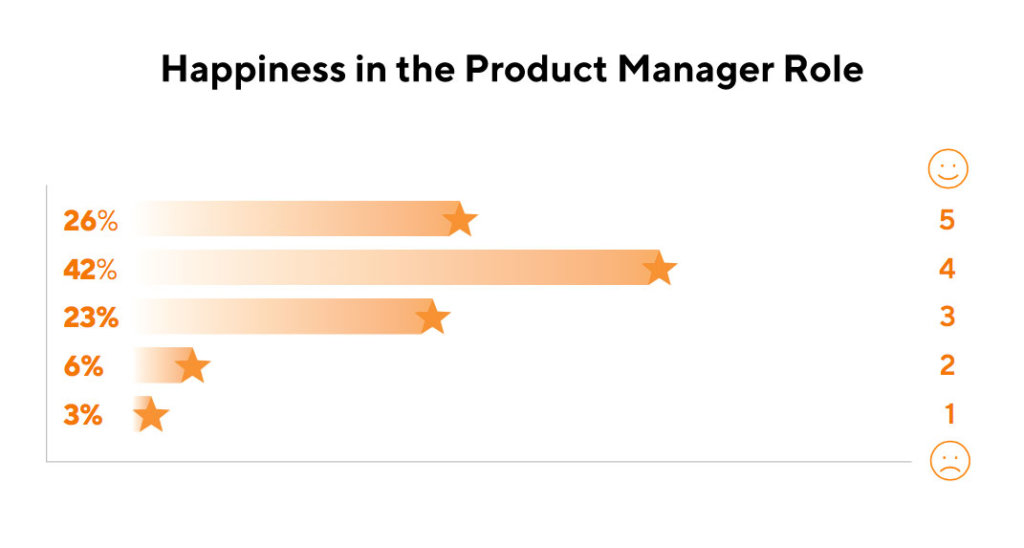What’s the secret to happiness? We’d tell you if we knew. But when it comes to finding happiness in your product management career, we’ve got some pretty good ideas.
Recently ProductPlan’s Co-founder Jim Semick hosted a panel discussion webinar with three veteran product managers. They dove into what makes product managers happy and how to overcome some of the common obstacles that stand in the way.
Happiness Insights for Successful Product Management Careers
Product managers are already starting from a pretty good place. According to our 2020 product management survey, 68% of product managers rank their happiness with the job a 4 or 5 on a five-point scale. Only 9% gave their happiness a 1 or 2 ranking, which makes for a pretty content cohort of product managers.

Jim believes there is no better job than product management. It forces practitioners to stretch themselves and be creative. And while it’s stressful at times, product managers tend to thrive in the chaos.
Panelist Kevin Steigerwald, Director of Product Design at Jama Software, also finds pleasure in the chaos. Product managers aren’t supposed to feel safe or content. Knowing that there would be new problems to solve all the time attracted him to the role. Instead of talking to the same people about the same old things every day, he enjoys the constant movement and energy required to thrive in that environment.
As one product manager in the audience puts it, “if you are not drawn to crazy, then you don’t belong in product.”
Beyond embracing the pandemonium, product managers find happiness in other aspects of the job. Panelist Candice Yono, Senior Product Manager at Pivotal, most enjoys the collaborative nature of the role.
“When you’re all coming together to solve a problem and seeing all the different takes people bring to the table,” she said. “coming up with a solution that no single person would have come up with on their own.”
The third panelist, Suzanne Abate, CEO of the Development Factory, had a slightly different take.
“Are product managers intrinsically happy, or does the job make them happy? Linking our happiness to the holy grail of our company finding success would be a dark path. You have to find happiness along the way,” she said. Adding that she most frequently hears product managers were taking the most joy in “people using or deriving benefit from your product. But it doesn’t have to be at scale—taking an idea, putting it into the market, and making a single person happy… the numbers don’t really matter.”
1. Happiness is in finding a positive environment
A common ingredient in product managers finding happiness is working in the right environment. For Steigerwald, that means a culture based on a build-measure-learn mentality. If that’s not there, he added, it creates fear because product managers worry their company will let them go if the product doesn’t find traction or users complain.
Semick echoed these sentiments, recalling how he removed himself from a self-created pressure cooker environment.
“I declared backlog bankruptcy – everything in the backlog wasn’t going to be built,” he said. “We decided to draw a line in the backlog and deleted everything. It was creating stress for the organization and me.”
2. Happiness is in setting Realistic Expectations
Yono thinks happiness can only happen when you don’t obsess over trying to satisfy everyone.
“You have to accept you can’t solve every problem, and you don’t have to fix them all,” she said. “I mentally look for the themes instead of trying to fix everything. Being realistic about what you can tackle and determining if an issue is aligned with the business objectives.”
Semick also warned against obsessing over feedback, saying you don’t have to track every iota of input.
“If it’s important enough, it will bubble up to the top,” he said. “If it’s important enough, it will eventually get done.”
Abate agrees with those feelings and says product managers can push back while still being seen as a team player by linking things back to OKRs.
“Suggest compromises and try to solve things in between,” she said, adding that it’s essential to understand why things are important “What are the implications? What are they willing to compromise on? If they can’t understand that everything isn’t important, then nothing is important.”

3. Geographically distributed learnings
Working in a geographically distributed environment was a challenge raised by one remote lead product manager.
“I am the only remote member of my product team, living in the US while others are in the India dev center,” they said. “Most of the time, I end up playing catch up, and due to lack of other PMs in my team, I end up getting stressed out and unsatisfied with my output.”
Yono, who is one of only two remote people on her team, has found ways to use the distance to her advantage.
She likes the balance of having time for herself (starting earlier due to being in a different time zone) to catch up. This way, “I know what I need to get and whom to communicate with and then do it during the overlap.”
When Semick was a remote product manager, he found “I had to double the amount of communication, overcommunicating to be sure the relationship with them is consistent.”
Hear more advice from Semick in the product manager Spotlights series below.

When Abate is advising remote teams, she encourages them to use a daily digest, which is essentially a journal for passing the baton through adding context. If something terrible happened, priorities changed, etc., the next team will know. Everyone can check in with the digest to know what’s on their plate when their shift starts.
4. Keep time on your side
Since a product manager’s job is never done, it’s hard to find time for everything. But our panelists all say one key to happiness is carving out time for yourself.
Semick was constantly working and was miserable until his team shipped their MVP. But once it got out the door, he reevaluated his priorities and started taking care of himself, working shorter days, and exercising, finding happiness once again.
Yono emphasizes how important it is to take real breaks, not just switching browser tabs to read the news or check out social media. Physically getting up and leaving your workspace is much more rejuvenating.
Abate concurs, emphasizing that product managers must prioritize themselves along with their backlog.
“Protect your time. There will always be a distraction or fire that comes up,” Abate said. “If you don’t map out in your schedule time to do something, you’ll never do it.”
For Steigerwald, it starts with lunch. “I keep my lunch break blocked and have lunch by myself knowing I always have that break in my day if I need it,” he said, adding that “at the end of my day I write down what I accomplished today and what I’m going to do tomorrow. Creates closure and lets me check out for the night, plus when I come in the next morning, I already know what I need to deal with.”
5. Elaboration on collaboration
Product management isn’t a separate discipline, but interacting with other departments is frequently cited as a challenge. Many view the engineering organization as the toughest nut to crack, but the panelists felt otherwise.
Abate encourages product managers to leverage a tool from the UX world and use empathy mapping to get outside yourself: What are you missing? What’s their why?
“I look at engineers as partners,” Yono said. “I reach out to them all the time with questions, and they’re willing to have that conversation and break things down. It helps me understand so we can all solve this problem together.”
“In my experience, my relationship and communication are much better with my development teams,” said a product owner in the audience. “It’s with the business stakeholders whom we (Product) have a tougher time communicating with.”
Yono said she has a regular, biweekly update cadence. “I like to demo or pull in visuals, and include any feedback sessions output,” she said.
Steigerwald emphasized that it’s important to remember what executives are looking to get out of these conversations. “They want quick short answers,” he said. “Is this going to be a problem? How big is it? What do you need from me to get it done?”
Find Happiness in Your Product Management Career
Both the panelists and the audience agree that the best parts of product management would be hard to replicate in another role.
One product manager in the audience cited their happiness stems from “The opportunity to have real input into effective change.” Another product manager values “the future of what we’re building, the realization of the strategic objectives we have set forth as a company.”
Yono added that even when times are rough, you can always “look for those moments of joy. Shift your thoughts to what you can control by framing the situation and the steps you can take yourself.”
Abate’s parting wisdom for finding and maintaining happiness was simply to commit.
“Understand why you’re in the role, make peace with it, and show up 100%.”
Ready to make the most of your life as a product manager? Check out our new ebook Mastering a Day in the Life of a Product Manager.




